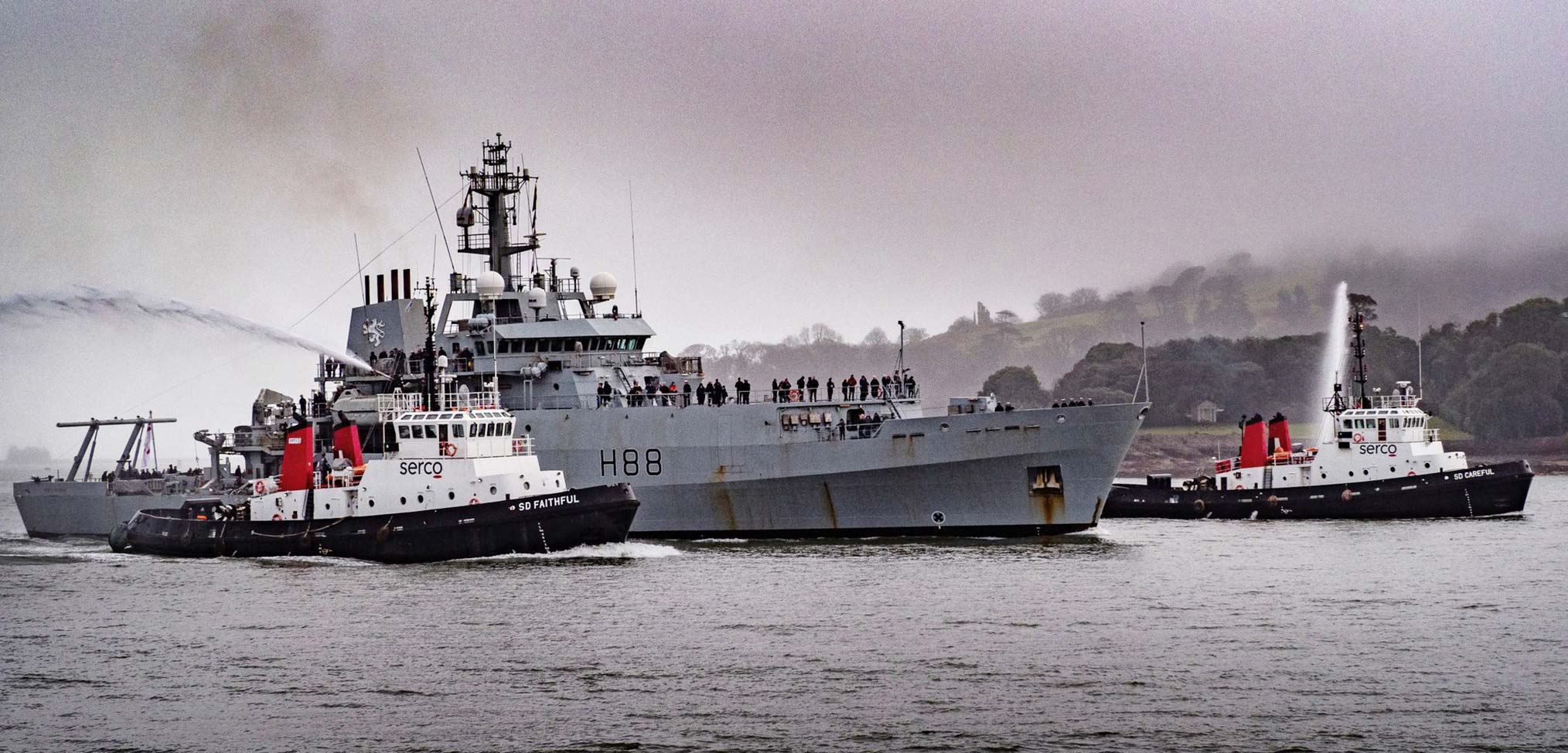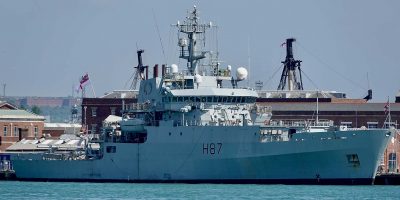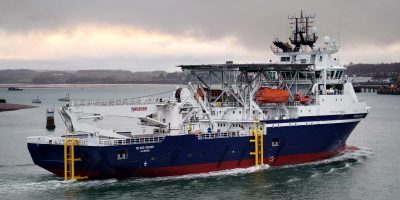
Why has the Royal Navy decommissioned 6 ships in a year?
In the last 12 months, a significant number of Royal Navy vessels have been retired. Funding shortfalls play a part but the situation is more complex than just cuts to save money. Here we look at the reasoning, the risks involved and the plans to replace the capabilities of these ships.
Sunset before sunrise
The six vessels that have left the fleet are RFA Wave Knight (laid up March 2022), HMS Echo (formally decommissioned June 2022), HMS Shoreham and HMS Grimsby (Oct 2022), HMS Enterprise and HMS Montrose (March 2023). These withdraws are essentially being made to release resources for new technologies elsewhere. This is what the MoD calls retiring “sunset platforms” in favour of introducing “sunrise capabilities”. An RN spokesperson said “it should be noted in many areas there won’t be like-for-like replacement as the next generation of capability won’t necessarily look like the kit that is being retired, particularly in the Mine Countermeasures (MCM) and Military Data Gathering (MDG) world”.
The positive view is that the RN is taking bold steps in order to be at the cutting edge of innovation, introducing autonomous or remotely controlled systems that can potentially deliver the same or better effect at lower cost than legacy ships. Cynics will label this more hollowing out justified by promises of “jam tomorrow” but in the long run, the RN should be in a good position and reap the benefits of being an early adopter.
There is understandable concern about the loss of hulls but it is important to consider overall naval capability rather than just count platforms. A hot debate rages about whether a mothership carrying task-specific off-board systems can fully replace the more rounded capability of conventional ships. Unfortunately, the RN lacks the funds and people to bring in new systems and fully prove them in service ahead of phased retirement for legacy platforms. Instead, it must pay off ships before it can make the investment in new technology. The RN acknowledges that taking these steps will create gaps and says that the risks have been carefully assessed.
Decommissioning any vessel comes with baggage that goes beyond merely hauling down a flag on a piece of metal. Attachments are formed by people who have served onboard over the years and by those involved in building and maintaining her. The ship also has deep connections with the community in its base port and affiliated towns, organisations and sponsors that give it a reach into the nation far beyond the dockyards. It is especially difficult to countenance the retirement of a vessel that appears to have further life left in it or when there is no new ship immediately ready to come forward to replace them.

RFA Wave Knight joined her sister RFA Wave Ruler (laid up in Birkenhead since 2018) in long-term lay-up in March 2022, primarily as a cost and manpower-saving measure. At least these relatively modern ships have not yet been listed for sale or scrap and could theoretically be reactivated in an emergency. The four new Tide-class tankers are just about adequate to support the RN’s peacetime operational tempo so mothballing the Wave class is a justifiable option when there are other priorities. The RFA has just added two new merchant ship conversions to its fleet that will be deployed in the mothership role and needs to generate crews for them from its limited personnel numbers.
Survey by drone
Despite the retirement of a second survey vessel, RN has not been especially forthcoming about its future plans for hydrography or what is more broadly now referred to as ‘Military Data Gathering’ (MDG). Project HECLA is known to be the programme to develop future hydrographic capabilities, increasingly based on off-board autonomous systems.
With HMS Echo and HMS Enterprise gone, the only conventional ocean survey vessel left is HMS Scott. She has already been extended in service at least until sometime this year, although another extension seems possible. She has spent the last two years operating from Gibraltar conducting mammoth surveys of the Central and North Atlantic using her powerful hull-mounted Sonar Array Sounding System that can map up to 150Km2 of seabed in an hour.
The merchant ship MV Topaz Tangaroa currently undergoing conversion at Cammell Laird will be renamed RFA Proteus and is the first Multi-Role Ocean Surveillance ship (MROS-1). It is expected she will be focused on protecting seabed infrastructure and make little, or minimal contribution to MDG. MROS-2 will be built from scratch to a bespoke design and is currently in the concept phase. If the project remains on track, she should be ready to deploy around 2029 and will have a greater deep-water MDG capability.
In 2021 a small Solcum glider UUV operated autonomously for 219 days, travelling 2,643km in the GIUK gap and sending 214Mb of survey data back to parent platforms. The glider can dive to a depth of 1,000m collecting data on temperature, depth, salinity, currents, oxygen levels, and turbulence, vital information for anti-submarine warfare. TAC HM (Tactical Hydrography, Meteorology and Oceanography) officers can interpret the data to provide advice to ASW forces on how to best optimise their sonars.
The ocean environments are changing and what used to apply 20-30 years ago is no longer the case, especially in the North Atlantic. Since May 2021, the RN has seeded the Atlantic from the High North to the Caribbean with 49 profiling floats that collect more than 5,000 oceanographic and weather observations per year. This data is more than the entire surface feet combined gathered in the last 5 years. Data can also be utilised in near real-time for tactical advantage, feeding directly into the Met office Ocean model and to the UK Hydrographic Office to improve climatological understanding. The floats consume little power, having a battery life of up to 4 years and there is a programme to deploy further profiling floats in other areas.
As part of a £6M contract, the RN recently took delivery of two Gavia Offshore Surveyor UUVs and three IVER 4 580 UUVs. These systems are typically used for survey tasks and are equipped with side-scan sonar, multi-beam echo sounders (MBES) and an acoustic doppler current profiler (ADCP). They also have an Ultra-Short Baseline positioning system (SSBL) an acoustic sub-bottom profiler (SBP), and an option for a conductivity, temperature, and depth (CDT) module. These are some of the enablers that may initially be deployed from RFA Proteus for underwater infrastructure monitoring but their sensor suites are also capable of hydrography and oceanography tasks.
This type of technology does not necessarily signal the end of the crewed survey vessel but the ability of autonomous systems to gather data more rapidly and at much-reduced cost opens up opportunities for new methods for surveying the oceans.

From minehunters to motherships
The transition to autonomous mine warfare in the Royal Navy is underway and the remaining Sandown-class MCMVs are being quickly decommissioned. The transfer of HMS Shoreham and HMS Grimsby to Ukraine last year follows the withdrawal of HMS Blyth and Ramsey in 2021 (subsequently sold to Romania). The RN now has an autonomous route survey capability based at Faslane and recently deployed the first mine hunting boat (RNMB Harrier) and its containerised Portable Operations Centre (POC) onto RFA Cardigan Bay in the Gulf. A more sophisticated capability will be delivered by the MMCM programme with autonomous boats that will be able to both detect and dispose of mines (More details here).
Former Offshore Support Vessel, MV Island Crown is currently in Devonport undergoing a light conversion to become a mothership for Autonomous mine warfare boats. She is to be re-named RFA Stirling Castle (Pennant number M100) and will initially be based in Faslane. It is believed that up to 4 more Mine Warfare/MDG Logistic Support Vessels (LSV) will be acquired sometime from the mid-2020s and will form the “Castle class”. They are listed in the National Shipbuilding Strategy as providing potential work for UK industry so it is possible they will be new-build vessels and/or a mix of merchant conversions. At least one LSV will replace the Bay-class RFA based in the Gulf as a mine warfare support ship.
In most scenarios, autonomous mine warfare systems have convincingly demonstrated during extensive trials they can perform the core task more quickly and efficiently than crewed minehunters. Exchanging conventional platforms for small boats operated from ashore or a mothership has many advantages, most importantly is the reduction in risk to personnel. Like the survey ships, the loss of MCMVs presents issues around the many other tasks performed by crewed vessels. This includes the message sent by the presence of a manned vessel that people can see and understand. Port visits by ships play an important role in personal engagement with local organisations, the general public and in support of defence diplomacy. They may also be deployed on surveillance, patrol and humanitarian aid missions, not forgetting the important command experience they provide for junior officers.
Autonomous systems have vulnerabilities that crewed platforms do not. While many conflicts remain in the threshold below open warfare it would be relatively easy for adversaries to destroy or simply steal the USVs. The recent deliberate destruction of a USAF MQ-9 Reaper UAV over the Black sea by Russian SU-27 jets is an example of how an adversary is much more likely to interfere with drones than a crewed platform as the risk of escalation is perceived to be much lower. There will be many fewer hulls, but at least the procurement of motherships offers a more substantive and persistent presence and allows mine hunting and hydrography capabilities to be deployed anywhere in the world.

Into the valley of risk
The retirement of HMS Monmouth (inactive since 2019) and HMS Montrose reduces the frigate fleet to 11 and it cannot return to 13 until sometime after 2028 when the first Type 26 and Type 31s become operational. As we have noted before, the premature decommissioning of these two tired ships saved the cost of expensive life extension refits. This is a sensible, if counter-intuitive, solution as the cash saved was redirected to refitting other ships and will actually provide greater overall frigate availability for the same cost.
The mid-2020s will be a period when the RN must endure an unavoidable low point in strength before it recovers in the early 2030s. There are three main factors that drive this, two of them rather beyond the RN’s immediate control. Firstly the backbone of the surface fleet, the Type 23s, are getting older and fewer in number. Secondly, the carrier strike project is some way from reaching its full potential mainly due to the slow delivery of F-35s, a constrained pilot training pipeline and obstacles to the integration of key air weapons. Finally, ship numbers are declining while the RN transitions to autonomous systems that are not yet fully mature or proven on operations.
The good news is the RN should become a stronger force in the 2030s with an increasingly modern frigate fleet (that also benefit from a lower crew requirement). Better armed jets will operate from the aircraft carriers in greater numbers and many of the teething problems with uncrewed systems will have been overcome. Other positives for the 2030s include reliable Type 45 destroyers upgraded with Sea Ceptor and modest anti-ballistic missile capability, all 7 Astute class submarines and 3 modern Fleet Solid Support ships will be in service. Of course, this is all well and good but adversaries’ capabilities are also evolving and the RN may be faced with challenges in the near term.














No comments:
Post a Comment
How did you like the post, leave a comment. I would appreciate hearing from you all. Best wishes from JC's Naval, Maritime and Military News